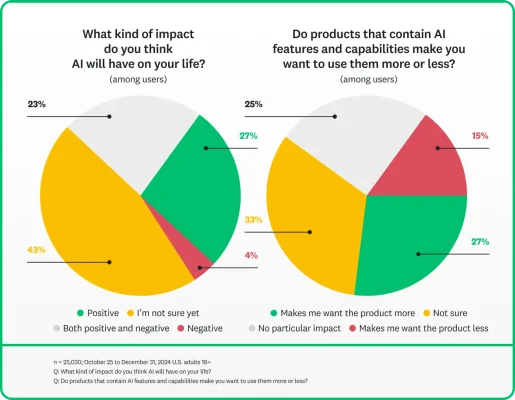Two years after ChatGPT sparked widespread AI adoption around the world, a new digital divide is emerging in the US, but perhaps not the one experts predicted. While traditional technology gaps often follow income or location, AI adoption in America splits clearly along generational lines. Our AI sentiment study reveals that while 24% of Americans have used AI in the past three months, how they use it varies dramatically by age.
This generational contrast is particularly striking as ChatGPT reaches its two-year milestone, sparking scores of new platforms broadly available to the public. Rather than seeing barriers based on economic access, we're witnessing preferences and comfort levels with AI that correlate strongly with age. Our AI sentiment study of 25,030 US adults shows younger users diving into AI for education and creative tasks, while older generations approach it more cautiously, focusing on practical applications.
AI usage statistics across age groups
Our latest data reveals distinct generational patterns in AI adoption and usage, with 30% of younger generations using it weekly. Each age group gravitates towards different applications.
Gen Z leads in educational use, with 61% using AI for learning and school. This contrasts sharply with older generations' focus on workplace applications: Gen X (53%) and Millennials (50%) primarily use AI for professional tasks.
Six in ten Gen Zers (61%) use AI for education. Work and general assistance are the top use cases across all other age groups.
Personal assistance applications bridge the generational divide, showing consistent adoption (41-48%) across age groups, which might include automating basic tasks like scheduling and reminders. However, comfort levels vary significantly for more personal applications—23% of Millennials use AI for emotional or mental health support compared to just 8% of Boomers.
This pattern of adoption suggests each generation is finding its own entry point to AI technology. While Gen Z largely relies on AI for learning, Millennials see higher usage of AI for fun and hobbies, and Gen X and Boomers are using the technology for workplace efficiency (as well as for fun).
Related reading: Millennials vs. Gen-X in the workplace: differences and similarities
Other AI adoption trends: how users feel
Equal portions (27%) of Americans across all age groups express skepticism or concern about AI, while 24% are impressed by its capabilities. This measured outlook suggests that while younger generations dive into AI for education and productivity—as a personal assistant, for example—older Americans take a more reserved approach, focusing on practical applications.
Our AI sentiment study proves that cautious optimism extends across demographics. Even among frequent AI users, most see both benefits and drawbacks to the technology. This balanced perspective appears particularly strong among Gen X and Boomers, who report higher levels of concern about privacy and accuracy compared to younger generations.
How AI features shape product perception
When it comes to products with AI capabilities, Americans' reactions mirror their overall sentiment about the technology. Only 27% say AI features positively influence their perception of products, while most see mixed impacts or remain uncertain. This measured response suggests that AI features alone might not automatically enhance product appeal. Users may want to see clear benefits before embracing AI-enabled tools—which could be the key to successfully developing and marketing those tools.

Looking ahead at AI adoption trends
The generational AI divide may be temporary. Since our April 2023 AI study, the percentage of Americans who believe AI will have a major impact on their lives in the next 5 years has jumped from 52% to 59%. This increase suggests that as Americans gain firsthand experience with AI tools, initial skepticism may be giving way to cautious acceptance, especially when benefits are clear and immediate.
This growth spans age groups, suggesting that while different generations currently approach AI differently, they share a common experience: AI's influence on daily life is only beginning to unfold.
As AI technology enters a new era following the mainstream breakthrough of ChatGPT, usage patterns suggest an evolving landscape shaped by generational priorities. Gen Z's broad adoption across education, productivity, and entertainment hints at AI becoming deeply integrated into both work and personal life. Meanwhile, older generations' preference for entertainment-focused AI applications over productivity tools may indicate untapped opportunities for workplace AI solutions—particularly for Gen X and Boomers who show interest but currently limited professional usage.
These distinct generational approaches to AI suggest that rather than seeing a convergence of usage patterns, we may instead see AI tools and platforms becoming increasingly tailored to age-specific needs and preferences, ultimately driving more personalized and effective AI solutions across all demographics.
Curious to learn what these AI trends could mean for marketing? See our article: 28 AI marketing statistics you need to know in 2025.
AI sentiment study conducted October-December 2024 among 25,030 US adults, with a ±1.0% margin of error. Data weighted to reflect US demographic composition.



